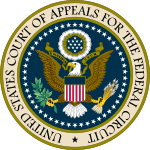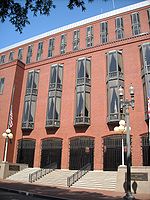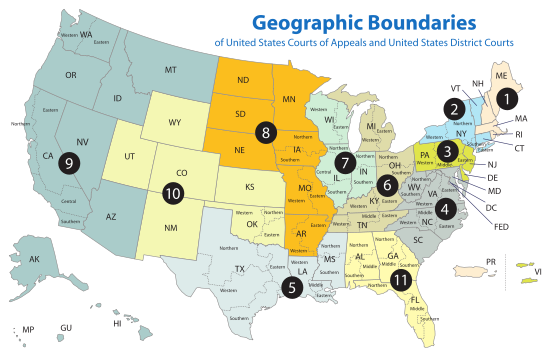- United States Court of Appeals for the Federal Circuit
-
United States Court of Appeals for the Federal Circuit 
Established 1982 Jurisdiction United States (specific subject matter) Location Washington, D.C. Composition method Presidential nomination with Senate confirmation Authorized by 28 U.S.C. § 1295 Decisions are appealed to Supreme Court of the United States Judge term length Life tenure Number of positions 12 Website http://www.cafc.uscourts.gov/ Chief Judge Currently Randall Ray Rader Since 2010 Lead position ends 2017 The United States Court of Appeals for the Federal Circuit (Federal Circuit; in case citations, Fed. Cir. or C.A.F.C.) is a United States court of appeals headquartered in Washington, D.C.. The court was created by Congress with passage of the Federal Courts Improvement Act of 1982, which merged the United States Court of Customs and Patent Appeals and the appellate division of the United States Court of Claims, making the judges of the former courts into circuit judges.[1][2]
The court occupies the Howard T. Markey National Courts Building, the Benjamin Ogle Tayloe House, the former Cosmos Club, and the Cutts-Madison House in Washington, D.C. The court sits from time to time in locations other than Washington, and its judges can and do sit by designation on the bench of other courts of appeals and federal district courts.
Contents
Jurisdiction
The Federal Circuit is unique among the courts of appeals as it is the only court that has its jurisdiction based wholly upon subject matter rather than geographic location. The Federal Circuit is an appellate court with jurisdiction generally given in 28 U.S.C. § 1295. The court hears certain appeals from all of the United States District Courts, appeals from certain administrative agencies, and appeals arising under certain statutes. Among other things, the Federal Circuit has exclusive jurisdiction over appeals from:[3]
- Article I tribunals:
- United States Court of Federal Claims
- United States Court of Appeals for Veterans Claims
- United States Trademark Trial and Appeal Board
- United States Board of Patent Appeals and Interferences
- Boards of Contract Appeals (for government contracts)
- United States Merit Systems Protection Board (federal employment and employment benefits)
- United States International Trade Commission
- Article III tribunals:
- United States Court of International Trade
- United States district courts relating to:
- Patents, including appeals arising from an action against the Commissioner of Patents and Trademarks under 35 U.S.C. § 145
- The Little Tucker Act, 28 U.S.C. § 1346
- Section 211 of the Economic Stabilization Act of 1970;
- Section 5 of the Emergency Petroleum Allocation Act of 1973;
- Section 506(c) of the Natural Gas Policy Act of 1978; and
- Section 523 of the Energy Policy and Conservation Act
Although the Federal Circuit typically hears all appeals from any of the United States district courts where the original action included a complaint arising under the patent laws, the Supreme Court has decided that it does not if the patent claims arose solely as counterclaims by the defendant.[4] Though other appellate courts can now hear patent counter-claims in theory, this has not happened often.
The decisions of the Federal Circuit, particularly in regard to patent cases, are unique in that they are binding precedent throughout the U.S. within the bounds of the court's subject-matter jurisdiction. This is unlike the other courts of appeals as the authority of their decisions is restricted by geographic location and thus there may be differing judicial standards depending on location. Decisions of the Federal Circuit are only superseded by decisions of the Supreme Court or by applicable changes in the law. Also, review by the Supreme Court is discretionary, so Federal Circuit decisions are often the final word, especially since there are usually no circuit splits given the Federal Circuit's exclusive subject-matter jurisdiction. In its first decision, the Federal Circuit incorporated as binding precedent the decisions of its predecessor courts, the United States Court of Customs and Patent Appeals and the appellate division of the United States Court of Claims.[5]
Because the Court is one of national jurisdiction, panels from the court may sit anywhere in the country. Typically, once or twice a year, the court will hold oral arguments in a city outside of its native Washington D.C. The panels may sit in Federal courthouses, state courthouses, or even at law schools.
Composition
The Federal Circuit may have a total of 12 active circuit judges sitting at any given time, who are required to reside within 50 miles of the District of Columbia, as set by 28 U.S.C. § 44. Judges on senior status are not subject to this restriction. As with other federal judges, they are nominated by the President and must be confirmed by the Senate. Their terms last during the "good behavior" of the judges, which typically results in life tenure. When eligible, judges may elect to take senior status. This allows a senior judge to continue to serve on the court while handling fewer cases than an active service judge. Each judge in active service employs a judicial assistant and up to four law clerks, while each judge in senior status employs a judicial assistant and one law clerk.[6]
Current composition of the court
As of November 8, 2011, the judges on the court are:
# Title Judge Duty station Born Term of service Appointed by Active Chief Senior 24 Chief Judge Randall Ray Rader Washington, DC 1949 1990–present 2010-present — G.H.W. Bush 16 Circuit Judge Pauline Newman Washington, DC 1927 1984–present — — Reagan 22 Circuit Judge Alan David Lourie Washington, DC 1935 1990–present — — G.H.W. Bush 26 Circuit Judge William Curtis Bryson Washington, DC 1945 1994–present — — Clinton 28 Circuit Judge Richard Linn Washington, DC 1944 1999–present — — Clinton 29 Circuit Judge Timothy B. Dyk Washington, DC 1937 2000–present — — Clinton 30 Circuit Judge Sharon Prost Washington, DC 1951 2001–present — — G.W. Bush 31 Circuit Judge Kimberly Ann Moore Washington, DC 1968 2006–present — — G.W. Bush 32 Circuit Judge Kathleen M. O'Malley Washington, DC 1956 2010–present — — Obama 33 Circuit Judge Jimmie V. Reyna Washington, DC 1952 2011–present — — Obama 34 Circuit Judge Evan Wallach Washington, DC 1949 2011–present — — Obama — Circuit Judge (vacant - seat 1) (n/a) (n/a) (n/a) (n/a) (n/a) (n/a) 19 Senior Circuit Judge Haldane Robert Mayer Washington, DC 1941 1987–2010 1997–2004 2010-present Reagan 21 Senior Circuit Judge S. Jay Plager Washington, DC 1931 1989–2000 (none) 2000–present G.H.W. Bush 23 Senior Circuit Judge Raymond Charles Clevenger III Washington, DC 1937 1990–2006[7] (none) 2006–present G.H.W. Bush 25 Senior Circuit Judge Alvin Anthony Schall Washington, DC 1944 1992–2009 — 2009–present G.H.W. Bush 27 Senior Circuit Judge Arthur J. Gajarsa Washington, DC 1941 1997–2011 — 2011-present Clinton Vacancies and pending nominations
Seat Seat Last Held By Vacancy Reason Date of Vacancy Nominee Date of Nomination 1 Paul Redmond Michel Retirement[8] May 31, 2010 Richard G. Taranto November 10, 2011 List of former judges
# Judge State Born/Died Active service Term as Chief Judge Senior status Appointed by Reason for
termination1 Don Nelson Laramore IN 1906–1989 (none) (none) 1982–1989 Eisenhower[9] death 2 Giles Sutherland Rich NY 1904–1999 1982–1999 (none) (none) Eisenhower[10] death 3 James Lindsay Almond, Jr. VA 1898–1986 (none) (none) 1982–1986 Kennedy[10] death 4 Oscar Hirsh Davis DC 1914–1988 1982–1988 (none) (none) Kennedy[9] death 5 Arnold Wilson Cowen TX 1905–2007 (none) (none) 1982-2007 L. Johnson[9] death 6 Philip Nichols, Jr. DC 1907–1990 1982–1983 (none) 1983–1990 L. Johnson[9] death 7 Byron George Skelton TX 1905–2004 (none) (none) 1982–2004 L. Johnson[9] death 8 Phillip Benjamin Baldwin TX 1924–2002 1982–1986 (none) 1986–1991 L. Johnson[10] retirement 9 Howard Thomas Markey IL 1920–2006 1982–1991 1982–1990 (none) Nixon[10] retirement 10 Marion Tinsley Bennett MO 1914–2000 1982–1986 (none) 1986–2000 Nixon[9] death 11 Shiro Kashiwa HI 1912–1998 1982–1986 (none) (none) Nixon[9] retirement 12 Jack Richard Miller IA 1916–1994 1982–1985 (none) 1985–1994 Nixon[10] death 13 Daniel Mortimer Friedman DC 1916-2011 1982–1989 (none) 1989–2011 Carter[9] death 14 Edward Samuel Smith MD 1919–2001 1982–1989 (none) 1989–2001 Carter[9] death 15 Helen Wilson Nies DC 1925–1996 1982–1995 1990–1994 1995–1996 Carter[10] death 17 Jean Galloway Bissell SC 1936–1990 1984–1990 (none) (none) Reagan death 18 Glenn Leroy Archer, Jr. DC 1929-2011 1985–1997 1994–1997 1997–2011 Reagan death 20 Paul Redmond Michel PA 1941- 1988–2010 2004–2010 (none) Reagan retirement Chief judges
Chief Judges Markey 1982–1990 Nies 1990–1994 Archer 1994–1997 Mayer 1997–2004 Michel 2004–2010 Rader 2010–present Chief judges have administrative responsibilities with respect to their circuits, and preside over any panel on which they serve unless the circuit justice (i.e., the Supreme Court justice responsible for the circuit) is also on the panel. Unlike the Supreme Court, where one justice is specifically nominated to be chief, the office of chief judge rotates among the circuit judges. To be chief, a judge must have been in active service on the court for at least one year, be under the age of 65, and have not previously served as chief judge. A vacancy is filled by the judge highest in seniority among the group of qualified judges. The chief judge serves for a term of seven years or until age 70, whichever occurs first. The age restrictions are waived if no members of the court would otherwise be qualified for the position.
When the office was created in 1948, the chief judge was the longest-serving judge who had not elected to retire on what has since 1958 been known as senior status or declined to serve as chief judge. After August 6, 1959, judges could not become chief after turning 70 years old. The current rules have been in operation since October 1, 1982.
Notwithstanding the foregoing, when the court was initially created, Congress had to resolve which chief judge of the predecessor courts would become the first chief judge. It was decided that the chief judge of the predecessor court who had the most seniority, as chief judge, would be the new chief judge.[11] This made Howard T. Markey, former chief judge of the Court of Customs and Patent Appeals, the first chief judge.
Succession of seats
The court has twelve seats for active judges, numbered in alphabetical order by their occupant at the time the court was formed, with the sole vacant seat being numbered last. Judges who retire into senior status remain on the bench but leave their seat vacant. That seat is filled by the next circuit judge appointed by the President.
Seat 1 Reassigned on April 2, 1982 from the United States Court of Customs and Patent Appeals by 96 Stat. 25 Baldwin 1982–1986 Michel 1988–2010 (vacant) 2010–present Seat 2 Reassigned on April 2, 1982 from the United States Court of Claims by 96 Stat. 25 Bennett 1982–1986 Mayer 1987–2010 Reyna 2011–present Seat 3 Reassigned on April 2, 1982 from the United States Court of Claims by 96 Stat. 25 Davis 1982–1988 Clevenger 1990–2006 Moore 2006–present Seat 4 Reassigned on April 2, 1982 from the United States Court of Claims by 96 Stat. 25 Kashiwa 1982–1986 Plager 1989–2000 Prost 2001–present Seat 5 Reassigned on April 2, 1982 from the United States Court of Claims by 96 Stat. 25 Friedman 1982–1989 Lourie 1990–present Seat 6 Reassigned on April 2, 1982 from the United States Court of Customs and Patent Appeals by 96 Stat. 25 Markey 1982–1990 Bryson 1994–present Seat 7 Reassigned on April 2, 1982 from the United States Court of Customs and Patent Appeals by 96 Stat. 25 Miller 1982–1985 Archer 1985–1997 Dyk 2000–present Seat 8 Reassigned on April 2, 1982 from the United States Court of Claims by 96 Stat. 25 Nichols 1982–1983 Newman 1984–present Seat 9 Reassigned on April 2, 1982 from the United States Court of Customs and Patent Appeals by 96 Stat. 25 Nies 1982–1995 Gajarsa 1997–2011 Wallach 2011–present Seat 10 Reassigned on April 2, 1982 from the United States Court of Customs and Patent Appeals by 96 Stat. 25 Rich 1982–1999 Linn 1999–present Seat 11 Reassigned on April 2, 1982 from the United States Court of Claims by 96 Stat. 25 Smith 1982–1989 Schall 1992–2009 O'Malley 2010–present Seat 12 Established on April 2, 1982 by 96 Stat. 25 Bissell 1984–1990 Rader 1990–present See also
- United States Court of Federal Claims
- Federal Circuit Bar Association
- Federal Circuit appointment history
- List of United States patent law cases
Notes
- ^ "Federal Courts Improvement Act of 1982". History or the Federal Judiciary. Federal Judicial Center. http://www.fjc.gov/history/home.nsf/page/landmark_22.html. Retrieved 2011-11-21.
- ^ Pub.L. 97-164 §165, 96 Stat. 50.
- ^ History of the Federal Circuit
- ^ Holmes Group, Inc. v. Vornado Air Circulation Systems, Inc., 2005. A bill to eliminate this situation, H.R. 2955, was proposed on June 16, 2005 in the 109th Congress, but never passed.
- ^ South Corp. v. United States, 690 F. 2d 1368 (Fed. Cir. 1982)
- ^ About the United States Court of Appeals for the Federal Circuit
- ^ "Federal Judiciary - Judicial Vacancies". Official website of the Alliance for Justice. Archived from the original on February 24, 2006. http://web.archive.org/web/20060224041807/http://www.afj.org/judicial/judicial_selection_resources/selection_database/judicialVacancies.asp. Retrieved March 16, 2006.
- ^ http://legaltimes.typepad.com/blt/2009/11/federal-circuit-chief-judge-paul-michel-announces-retirement.html
- ^ a b c d e f g h i Reassigned from the United States Court of Claims pursuant to the Federal Courts Improvement Act of 1982, Pub.L. 97-164 §165, 96 Stat. 50.
- ^ a b c d e f Reassigned from the United States Court of Customs and Patent Appeals pursuant to the Federal Courts Improvement Act of 1982, Pub.L. 97-164 §165, 96 Stat. 50.
- ^ Pub.L. 97-164 §166, 96 Stat. 50.
References
- "OSCAR". Federal Law Clerk Information System. https://oscar.symplicity.com/index.php?_tab=judges. Retrieved May 21, 2008.
- source for the duty stations for senior judges
- "U. S. Court of Appeals for the Federal Circuit". History of the Federal Judiciary. Federal Judicial Center. http://www.fjc.gov/history/home.nsf/page/courts_coa_circuit_fc.html. Retrieved October 21, 2011.
- source for the state, lifetime, term of active judgeship, term of chief judgeship, term of senior judgeship, appointer, termination reason, and seat information
Further reading
- Bennett, Marion T. (1991). The United States Court of Appeals for the Federal Circuit: A History, 1982–1990. Washington, D.C.: United States Judicial Conference Committee on the Bicentennial of the Constitution of the United States. LCCN 91-601231.
- United States Court of Appeals for the Federal Circuit: A History: 1990–2002 / compiled by members of the Advisory Council to the United States Court of Appeals for the Federal Circuit in celebration of the court's twentieth anniversary.. Washington, D.C.: U.S. Court of Appeals for the Federal Circuit. 2004. LCCN 2004-050209.
- Abramson, Bruce D. (2007). The Secret Circuit: The Little-Known Court Where the Rules of the Information Age Unfold. Rowman & Littlefield. ISBN 978-0-7425-5281-4.
External links
- United States Court of Appeals for the Federal Circuit
- Recent opinions from Findlaw
- The Federal Circuit Bar Association
- The Federal Circuit Historical Society
- The Federal Circuit Bar Journal
United States courts of appeals 1st Circuit · 2nd Circuit · 3rd Circuit · 4th Circuit · 5th Circuit · 6th Circuit · 7th Circuit · 8th Circuit · 9th Circuit · 10th Circuit · 11th Circuit · DC Circuit · Federal CircuitCategories:- United States patent law
- United States Court of Appeals for the Federal Circuit
- Government in Washington, D.C.
- Article I tribunals:
Wikimedia Foundation. 2010.


